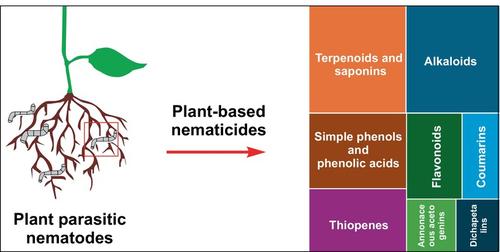当前位置:
X-MOL 学术
›
Pest Manag. Sci.
›
论文详情
Our official English website, www.x-mol.net, welcomes your
feedback! (Note: you will need to create a separate account there.)
Naturally‐occurring nematicides of plant origin: two decades of novel chemistries
Pest Management Science ( IF 3.8 ) Pub Date : 2024-11-06 , DOI: 10.1002/ps.8504 Hashim Ibrahim, Vaderament‐A. Nchiozem‐Ngnitedem, Louise‐Marie Dandurand, Inna Popova
Pest Management Science ( IF 3.8 ) Pub Date : 2024-11-06 , DOI: 10.1002/ps.8504 Hashim Ibrahim, Vaderament‐A. Nchiozem‐Ngnitedem, Louise‐Marie Dandurand, Inna Popova

|
Plant‐parasitic nematodes are among the most destructive plant pathogens, resulting in a global annual economic loss of about 358 billion dollars. Using synthetic nematicides to control plant‐parasitic nematodes has resulted in broad‐spectrum toxicity to the environment. Plant‐derived secondary metabolites have recently emerged as viable options that provide effective, greener, and renewable routes for managing plant‐parasitic nematodes in various cropping systems. However, limited comprehensive information on plant‐derived secondary metabolites sources, chemical structures, and nematicidal activities is available. This study aims to compile and analyze data on plant‐based secondary metabolites with nematicidal properties collected over the last two decades. In this review, we identified 262 plant‐based metabolites with nematicidal activities that were isolated from 35 plant families and 65 plant species. Alkaloids, terpenoids, saponins, flavonoids, coumarins, thiophenes, and annonaceous acetogenins were among the most studied compounds. In addition to the structure–activity relation for specific metabolites with nematicidal potency, various techniques for their extraction and isolation from plant material are discussed. Our findings demonstrate the potential of plants as a feedstock for sourcing nematicidal compounds and discovering new chemistries that could potentially be used for developing the next generation of nematicides. © 2024 The Author(s). Pest Management Science published by John Wiley & Sons Ltd on behalf of Society of Chemical Industry.
中文翻译:

植物来源的天然杀线虫剂:二十年的新型化学反应
植物寄生线虫是最具破坏性的植物病原体之一,每年导致全球经济损失约 3580 亿美元。使用合成杀线虫剂控制植物寄生线虫对环境产生了广谱毒性。植物来源的次生代谢物最近已成为可行的选择,为管理各种种植系统中的植物寄生线虫提供了有效、更绿色和可再生的途径。然而,关于植物来源的次生代谢物来源、化学结构和杀线虫活性的全面信息有限。本研究旨在汇编和分析过去二十年收集的具有杀线虫特性的植物性次生代谢物的数据。在这篇综述中,我们从 35 个植物科和 65 个植物物种中分离出 262 种具有杀线虫活性的植物代谢物。生物碱、萜类化合物、皂苷、黄酮类化合物、香豆素、噻吩和番荔枝素是研究最多的化合物。除了具有杀线虫效力的特定代谢物的结构-活性关系外,还讨论了从植物材料中提取和分离它们的各种技术。我们的研究结果表明,植物具有作为采购杀线虫化合物和发现可能用于开发下一代杀线虫剂的新化学物质的潜力。© 2024 作者。由John Wiley & Sons Ltd代表化学工业协会出版的《害虫管理科学》。
更新日期:2024-11-06
中文翻译:

植物来源的天然杀线虫剂:二十年的新型化学反应
植物寄生线虫是最具破坏性的植物病原体之一,每年导致全球经济损失约 3580 亿美元。使用合成杀线虫剂控制植物寄生线虫对环境产生了广谱毒性。植物来源的次生代谢物最近已成为可行的选择,为管理各种种植系统中的植物寄生线虫提供了有效、更绿色和可再生的途径。然而,关于植物来源的次生代谢物来源、化学结构和杀线虫活性的全面信息有限。本研究旨在汇编和分析过去二十年收集的具有杀线虫特性的植物性次生代谢物的数据。在这篇综述中,我们从 35 个植物科和 65 个植物物种中分离出 262 种具有杀线虫活性的植物代谢物。生物碱、萜类化合物、皂苷、黄酮类化合物、香豆素、噻吩和番荔枝素是研究最多的化合物。除了具有杀线虫效力的特定代谢物的结构-活性关系外,还讨论了从植物材料中提取和分离它们的各种技术。我们的研究结果表明,植物具有作为采购杀线虫化合物和发现可能用于开发下一代杀线虫剂的新化学物质的潜力。© 2024 作者。由John Wiley & Sons Ltd代表化学工业协会出版的《害虫管理科学》。


















































 京公网安备 11010802027423号
京公网安备 11010802027423号